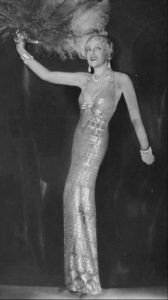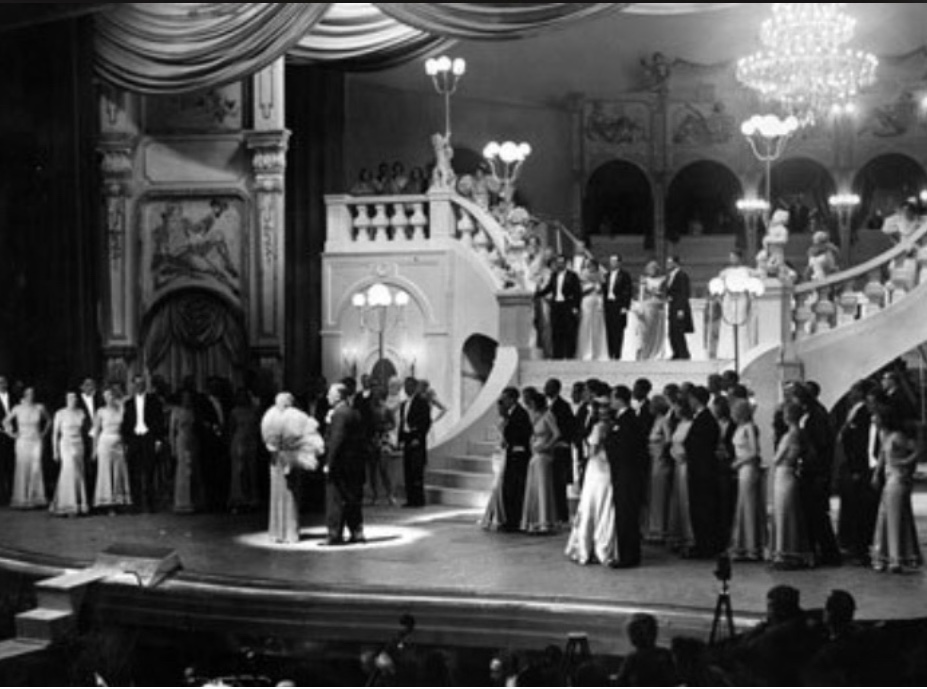Ball at the Savoy: the last major cultural event of Weimar Germany.
By Hersh Glagov

Gitta Alpár
In 1930, an operetta called Viktoria und ihr Husar (Victoria and her Hussar), which had enjoyed some success in Budapest, was performed in Berlin. It was a huge success, eventually playing in 300 theaters all over Europe. The German public had never heard anything like it. Its composer, Paul Ábrahám, classically trained but endlessly inventive and adaptable, had invented the jazz operetta. Jazz, with its syncopation, its distinctive harmonies, and its exotic instrumentation, had become all the rage in Weimar Germany and especially in Berlin. Abrahám’s catchy melodies were scored for an orchestra augmented by a jazz band, including steel guitar, piano, drum set, guitar, and banjo. Within months of his arrival in Berlin, Abrahám was a wealthy man. He bought a rococo-style villa in Berlin, where he gave legendary parties that were attended by the cream of Berlin society. At the same time, he continued to work at a frenetic pace, composing and conducting operettas and film scores. His next operetta, Die Blume von Hawaii (The Flower of Hawaii, 1931), was an even bigger success. At the same time, of course, a storm was brewing. Abrahám was harassed by Nazis as he went about his work in the film studio. His days in Berlin were numbered. For his next operetta, Ball im Savoy (Ball at the Savoy), Abraham once again collaborated with Fritz Löhner-Beda and Alfred Grünwald, the leading librettists of the time. It was the same team that had created Viktoria und ihr Husar and Die Blume von Hawaii. The plot is strongly reminiscent of Die Fledermaus: when a married man lies to his wife so that he can go to a ball without her, she takes her revenge by attending the same ball in disguise. The music reflects a variety of influences, both European and American. Listeners should not be too surprised to find a strong resemblance between some of the show’s musical numbers and such well-known American songs as “Night and Day” and “Makin’ Whoopee.” In the scoring, one is occasionally reminded of Kurt Weill, which should also come as no surprise. Weill and Abrahám, both with classical backgrounds, were listening to and influenced by a lot of the same popular music. Ball im Savoy was presented by Berlin’s most important theatrical producers, the Rotter Brothers, who used Max Reinhardt’s 3,300 seat Grosses Schauspielhaus in Berlin for the opening performance.The premiere took place on 23 December 1932. For some, that evening at the Metropol Theater was the last major cultural event of Weimar Germany. The opening night was a smashing success. With many dignitaries in attendance, the show went on until after midnight. The show’s star, the stunning young Hungarian soprano Gitta Alpár, was compelled to sing multiple encores. Adding to the evening’s success were the comic duo of Rosy Barsony and Oscar Dénes, two Hungarians that Abrahám had brought to Berlin and who had achieved great popularity. According to Abrahám’s biographer, Klaus Waller, “The Berlin operetta audience had only been this rapturous at performances by the great tenor Richard Tauber in operettas by Franz Lehár.” Quoting writer Maurus Pacher, who was there that night, he continues: “Long after midnight, the entire ensemble moves through the theater in a circle, holding colored lanterns, and Gitta Alpár sings Toujours l’amour once again, this time from the back of the house.’ Her colleagues, Rosy Barsony and Oskar Dénes,

Rosy Barsóny, Gitta Alpár and Paul Abrahám at the opening night party of Ball im Savoy, 1932.
were celebrated as much as she was. A dream of an evening.” The critic of the Vossische Zeitungwrote, ” There has been many a glamorous evening at the Grosses Schauspielhaus, but there has never been one more glamorous than last night.” At the heart of the great production, of course, was Abrahám’s music. Critic Ernst Decsey, did not hold back: ” Paul Abrahám (I say this with my hat off) is a Richard Strauss and at times even a Stravinsky of modern operetta.” The Berliner Morgenpost had special praise for Oskar Dénes and Rosy Barsony, who were making their first joint Berlin appearance: “Barsony is the epitome of temperament and buoyant dance, always the joker in blonde curls, a tuxedo and top hat, letting loose the hundred thousand devils of her infectious exuberance. In Oskar Dénes she has no ordinary dance partner. The élan of his dancing, his wit and trenchant delivery, especially with the laughing songs, have not seen their equal in many years.”
 The show’s opening triumph would be short-lived. Alpár, Barsony, and Dénes were Jewish. Thus, Ball im Savoy was written, produced, and performed by Jews, a fact that was not lost on the Nazis. Although the Berlin papers praised Ball im Savoy, Goebbels’s newspaper, Der Angriff (The Attack), saw the show differently: “The most expensive stars were hired that were supposed to bring some pizzazz into the place with all their skills. So alongside empty scenes that only had revue razzle dazzle, there were a few scenes that might have been pleasing in their light colorful character if one didn’t have to watch this whole theatrical apparatus that was drummed up by the Rotters to put four foreigners on the stage in the harsh footlights; if one didn’t have to listen to three actors who were paid huge sums of money to mangle our German language; and if the foreign composer Abrahám weren’t on the conductor’s podium.” The Rotter brothers threw a lavish party after the premiere, but they never saw a penny of the ticket sales. Their possessions were seized by one of their creditors (an avowed Nazi) and the brothers were forced to flee in mid-January 1933. Hoping to gain access to some of their money in Switzerland, they first went to Liechtenstein, but were kidnapped there by local Nazis. Alfred and his wife fell to their deaths while trying to escape. Fritz was injured, but survived and managed to get away. In Berlin, Ball im Savoy continued to play, but under dire circumstances. Outside the theater, audience members were being harassed by Nazis, and shows were being regularly disrupted. Abrahám, who had also been working on films during the day, now found himself a target of harassment by extras on the studio lots. The show finally closed on April 2, 1933. Barely one month after the premiere, Adolf Hitler became Chancellor of Germany. Abrahám, along with the stars of the show, had to leave the country in haste. Abrahám could no longer ignore the storm clouds that were gathering around him. The director Geza von Cziffra remembered a conversation he had with him at the time: When Paul Abrahám had to leave Berlin in 1933, he cried: “I wanted to die in this city.” Cziffra said to him, “You can still do that, Paul. When this horrific episode is over you can come back.” Abrahám replied, sobbing, “But why do I have to go? Just because I’m circumcised?” Abrahám left a number of unpublished song manuscripts in a safe at his villa; his butler, to whom he had given the key, allegedly sold these manuscripts to non-Jewish composers who published them under their own names and were credited with hit songs. Abrahám spent the next five years living and composing in Budapest and Vienna. Although his music was banned in Germany, it continued to be performed in the rest of Europe. In 1933 Viktoria und ihr Husar (Victoria and her Husar) and Die Blume von Hawaii (The Flower of Hawaii) opened in Paris, while Ball im Savoy opened in London, Vienna, and Budapest. Abrahám was given a ten minute standing ovation at the Budapest premiere. In as much as he still held his Hungarian passport, Abrahám’s arrival in Budapest wasn’t technically an exile. He immediately set to work on new film scores as well as another operetta. Work was the best therapy against his sudden departure from Berlin. Over the next five years in Budapest, he would write eight new operettas and six film scores, including a film version of Ball im Savoy which would feature many of the show’s original stars. In 1938, with the Anschluss, he was no longer welcome in Vienna; by 1939, with fascism on the rise in Hungary, he was forced to flee Budapest as well. Abrahám went to Paris; then, as the Nazis approached, he fled once again, first to Havana, eventually landing in New York. Abrahám’s time in New York was marked by professional disappointments. His dreams of success in Hollywood or on Broadway came to naught. For an American public used to a steady diet of Gershwin and Cole Porter, Abrahám’s work held no novelty. The Shubert Brothers had acquired the rights to his Ball at the Savoy but showed no interest in producing it. Reunited in New York, Abrahám and Alfred Grünwald collaborated on a new operetta, but it was never performed. At the same time, Abrahám was showing increasing signs of mental illness. In 1946, he wandered out onto Madison Avenue, positioned himself on the median, and –wearing his customary white gloves –began to conduct an imaginary orchestra. He was immediately arrested for being a hazard to traffic. A friend was able to have him moved to Creedmoor Mental Hospital, where he remained for the next ten years. In 1956, with the war over and Abrahám’s music once again popular in Germany, the Paul Abrahám Committee was formed to raise the necessary funds to bring him back to Germany. Arriving in Hamburg, he was reunited with his wife, whom he had not seen since before the war. The two of them lived in Hamburg until Abrahám’s death in 1960. During those final years, he still believed he was in New York and wrote to friends of impending premieres of his latest shows. Abrahám lived the last 20 years of his life in a sadly diminished state, a far cry from his Berlin days. He had breathed new life into the art form of operetta and pointed it in a new direction. Then, history intervened, and Abrahám’s career was cut short by circumstances beyond his control. But if his genius was extinguished too soon, how fortunate we are that we can still enjoy his remarkable creations today.
The show’s opening triumph would be short-lived. Alpár, Barsony, and Dénes were Jewish. Thus, Ball im Savoy was written, produced, and performed by Jews, a fact that was not lost on the Nazis. Although the Berlin papers praised Ball im Savoy, Goebbels’s newspaper, Der Angriff (The Attack), saw the show differently: “The most expensive stars were hired that were supposed to bring some pizzazz into the place with all their skills. So alongside empty scenes that only had revue razzle dazzle, there were a few scenes that might have been pleasing in their light colorful character if one didn’t have to watch this whole theatrical apparatus that was drummed up by the Rotters to put four foreigners on the stage in the harsh footlights; if one didn’t have to listen to three actors who were paid huge sums of money to mangle our German language; and if the foreign composer Abrahám weren’t on the conductor’s podium.” The Rotter brothers threw a lavish party after the premiere, but they never saw a penny of the ticket sales. Their possessions were seized by one of their creditors (an avowed Nazi) and the brothers were forced to flee in mid-January 1933. Hoping to gain access to some of their money in Switzerland, they first went to Liechtenstein, but were kidnapped there by local Nazis. Alfred and his wife fell to their deaths while trying to escape. Fritz was injured, but survived and managed to get away. In Berlin, Ball im Savoy continued to play, but under dire circumstances. Outside the theater, audience members were being harassed by Nazis, and shows were being regularly disrupted. Abrahám, who had also been working on films during the day, now found himself a target of harassment by extras on the studio lots. The show finally closed on April 2, 1933. Barely one month after the premiere, Adolf Hitler became Chancellor of Germany. Abrahám, along with the stars of the show, had to leave the country in haste. Abrahám could no longer ignore the storm clouds that were gathering around him. The director Geza von Cziffra remembered a conversation he had with him at the time: When Paul Abrahám had to leave Berlin in 1933, he cried: “I wanted to die in this city.” Cziffra said to him, “You can still do that, Paul. When this horrific episode is over you can come back.” Abrahám replied, sobbing, “But why do I have to go? Just because I’m circumcised?” Abrahám left a number of unpublished song manuscripts in a safe at his villa; his butler, to whom he had given the key, allegedly sold these manuscripts to non-Jewish composers who published them under their own names and were credited with hit songs. Abrahám spent the next five years living and composing in Budapest and Vienna. Although his music was banned in Germany, it continued to be performed in the rest of Europe. In 1933 Viktoria und ihr Husar (Victoria and her Husar) and Die Blume von Hawaii (The Flower of Hawaii) opened in Paris, while Ball im Savoy opened in London, Vienna, and Budapest. Abrahám was given a ten minute standing ovation at the Budapest premiere. In as much as he still held his Hungarian passport, Abrahám’s arrival in Budapest wasn’t technically an exile. He immediately set to work on new film scores as well as another operetta. Work was the best therapy against his sudden departure from Berlin. Over the next five years in Budapest, he would write eight new operettas and six film scores, including a film version of Ball im Savoy which would feature many of the show’s original stars. In 1938, with the Anschluss, he was no longer welcome in Vienna; by 1939, with fascism on the rise in Hungary, he was forced to flee Budapest as well. Abrahám went to Paris; then, as the Nazis approached, he fled once again, first to Havana, eventually landing in New York. Abrahám’s time in New York was marked by professional disappointments. His dreams of success in Hollywood or on Broadway came to naught. For an American public used to a steady diet of Gershwin and Cole Porter, Abrahám’s work held no novelty. The Shubert Brothers had acquired the rights to his Ball at the Savoy but showed no interest in producing it. Reunited in New York, Abrahám and Alfred Grünwald collaborated on a new operetta, but it was never performed. At the same time, Abrahám was showing increasing signs of mental illness. In 1946, he wandered out onto Madison Avenue, positioned himself on the median, and –wearing his customary white gloves –began to conduct an imaginary orchestra. He was immediately arrested for being a hazard to traffic. A friend was able to have him moved to Creedmoor Mental Hospital, where he remained for the next ten years. In 1956, with the war over and Abrahám’s music once again popular in Germany, the Paul Abrahám Committee was formed to raise the necessary funds to bring him back to Germany. Arriving in Hamburg, he was reunited with his wife, whom he had not seen since before the war. The two of them lived in Hamburg until Abrahám’s death in 1960. During those final years, he still believed he was in New York and wrote to friends of impending premieres of his latest shows. Abrahám lived the last 20 years of his life in a sadly diminished state, a far cry from his Berlin days. He had breathed new life into the art form of operetta and pointed it in a new direction. Then, history intervened, and Abrahám’s career was cut short by circumstances beyond his control. But if his genius was extinguished too soon, how fortunate we are that we can still enjoy his remarkable creations today.

